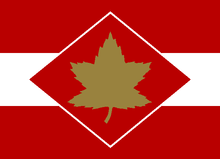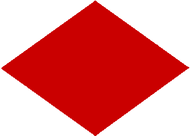I Canadian Corps
| I Canadian Corps | |
|---|---|
|
Formation patch worn by corps-level personnel. | |
| Active | 1942–1945 |
| Country |
|
| Branch | Canadian Army |
| Type | Corps |
| Commanders | |
| Notable commanders |
Eedson Burns Charles Foulkes |

I Canadian Corps was one of the two corps fielded by the Canadian Army during the Second World War.
History
From December 24, 1940 until the formation of the First Canadian Army in April 1942, there was a single unnumbered Canadian Corps. I Canadian Corps became operational in Italy in November 1943 when the 5th Canadian (Armoured) Division joined the 1st Canadian Infantry Division, which had been assigned to the British Eighth Army immediately prior to the Allied invasion of Sicily in July 1943. I Canadian Corps was commanded successively by Lieutenant-General Harry Crerar (April 6, 1942 to March 19, 1944), Lieutenant-General Eedson Burns (March 20, 1944 to November 5, 1944), and Lieutenant-General Charles Foulkes (November 10, 1944 to July 17, 1945).
However, the 1st Canadian Infantry Division took part in the Italian Campaign, participating in the Moro River Campaign and the Battle of Ortona in December 1943 as part of British V Corps and it was not until the fourth Battle of Monte Cassino (Operation Diadem) in May 1944 that I Canadian Corps fought its first battle as a corps. The Eighth Army held the Corps in reserve until after the Gustav defences in the Liri valley had been broken and then brought it forward to assault successfully the next defensive line, the Hitler Line, shortly before the Allied capture of Rome in early June. Having taken part in the Allies' northward advance to Florence, the Corps then took part in Operation Olive, the assault on the Gothic Line in September 1944 before being transported during January–February 1945 in Operation Goldflake to rejoin the rest of the First Canadian Army in Belgium and the Netherlands. There the Corps participated in the campaign to complete the liberation of the Netherlands. On May 6, 1945 at Wageningen, Lieutenant-General Foulkes received the final surrender by Colonel General Johannes Blaskowitz of all remaining German forces still active in the Netherlands. The Corps was deactivated on July 17, 1945 as part of general demobilization.
Although nominally a Canadian formation, I Canadian Corps contained significant elements at different times from other Allied countries. For example, in Italy, during the assault on the Gothic Line in the Fall of 1944, the Corps included the British 4th Infantry Division, the 2nd New Zealand Division and the 3rd Greek Mountain Brigade. During the final campaign to liberate the Netherlands, the Corps included for a time the British 49th Infantry Division.
21st century
In 2015, personnel of the Canadian Army Doctrine and Training Centre, headquartered at Kingston, began wearing the formation patch of I Canadian Corps on their ceremonial and service dress uniforms.[1]
Major operations


- Operation Timberwolf, December 1943
- Operation Morning Glory, December 1943
- Operation Diadem, Liri Valley Offensive, May 1944
- Operation Olive, assault on the Gothic Line, September 1944
- Operation Goldflake, transport from Italy to the Netherlands, February–March 1945
- Operation Destroyer, advance from Nijmegen to Arnhem, April 1945
- Advance to Harderwijk on the coast of the IJsselmeer, April 1945
- Liberation of the Netherlands, March–May 1945
- Lieutenant-General Foulkes receives the surrender of all German forces in the Netherlands, May 6, 1945
- Security duties, delivery of relief supplies and infrastructure repair projects in the Netherlands, May–July, 1945
Order of Battle in Italy, 1944-45
- 1st Canadian Infantry Division
- 5th Canadian Armoured Division
- 1st Canadian Armoured Brigade
- Corps Troops
- I Corps Defence Company, Lorne Scots
- 7th Anti-Tank Regiment, Royal Canadian Artillery (RCA)
- 1st Survey Regiment, RCA
- 9th Field Park Company, Royal Canadian Engineers (RCE)
- 12th Field Company, RCE
- 13th Field Company, RCE
- 14th Field Company, RCE
- 1st Drilling Company, RCE
- I Canadian Corps Headquarters Signals, Royal Canadian Corps of Signals
- No. 31 Corps Troops Company, Royal Canadian Army Service Corps (RCASC)
- No. 32 Corps Troops Company, RCASC
- I Canadian Corps Transport Company, RCASC
- No. 1 Motor Ambulance Company, RCASC
- No. 1 Headquarters Corps Car Company, RCASC
- Nos. 4 & 5 Casualty Clearing Stations, Royal Canadian Army Medical Corps (RCAMC)
- No. 8 Field Dressing Section, RCAMC
- No. 5 Field Hygiene Section, RCAMC
- Nos. 1, 3 & 8 Dental Companies, Canadian Dental Corps (CDC)
- No. 11 Base Dental Company, CDC
- No. 1 Corps and Army Troops Sub-Park, Royal Canadian Ordnance Corps (RCOC)
- I Corps Troops Workshop, Royal Canadian Electrical and Mechanical Engineers (RCEME)
- No. 1 Recovery Company, RCEME
- No. 3 Provost Company, Canadian Provost Corps (C Pro C)
- Attached First Canadian Army Troops
- No. 1 Army Group Royal Canadian Artillery
- 11th Army Field Regiment, RCA
- 1st Medium Regiment, RCA
- 2nd Medium Regiment, RCA
- 5th Medium Regiment, RCA
- No. 41 Army Transport Company, RCASC
- "H" Squadron, 25th Canadian Armoured Delivery Regiment (The Elgin Regiment), Canadian Armoured Corps
- Nos. 1, 2 & 3 Field Transfusion Units, RCAMC
- Nos. 3 & 16 Field Dressing Stations, RCAMC
- Nos. 1, 3, 5, 14, 15 & 28 General Hospitals, RCAMC
- No. 1 Convalescent Depot, RCAMC
- Nos. 1, 2 & 3 Field Surgical Units, RCAMC
- No. 1 Army Group Royal Canadian Artillery
Commanders[2]
- Lieutenant-General Andrew G. L. McNaughton, (July 19, 1940 to April 5, 1942)
- Lieutenant-General Harry Crerar (April 8, 1942 to March 19, 1944)
- Lieutenant-General Eedson Burns (March 20, 1944 to November 5, 1944)
- Lieutenant-General Charles Foulkes (November 10, 1944 to July 17, 1945)
See also
References
- Byers, A. R. (ed.), The Canadians at War 1939/45, 2nd ed., The Reader's Digest Association (Canada) Ltd., Montreal, Canada, 1986, ISBN 0-88850-145-5.
- Copp, Terry, Cinderella Army: The Canadians in Northwest Europe 1944-1945, University of Toronto Press, Toronto, Canada, 2007, ISBN 978-0-8020-9522-0.
- Nicholson, G.W.L. (1956). Official history of the Canadian Army in the Second World War, Vol II The Canadians in Italy, 1943-1945. Ottawa: Queen's Printer.
- Stacey, C.P. (1960). Official history of the Canadian Army in the Second World War, Vol III The Victory Campaign, The Operations in Northwest Europe 1944-1945. Ottawa: Queen's Printer.
- Zuehlke, Mark (2003). The Liri Valley: Canada's World War II Breakthrough to Rome. Douglas & McIntyre. ISBN 978-1-55365-013-3.
- Zuehlke, Mark (2006). The Gothic Line: Canada's Month of Hell in World War II Italy. Douglas & McIntyre. ISBN 978-1-55365-068-3.
Notes
- ↑ As shown on the Combat Training Centre website at facebook.com on 27 July 2015
- ↑ Col. C. P. Stacey, Official History of the Canadian Army in the Second World War: The Canadian Army 1939-1945: An Official Historical Summary, Department of National Defence, Ottawa, Canada, 1948.
